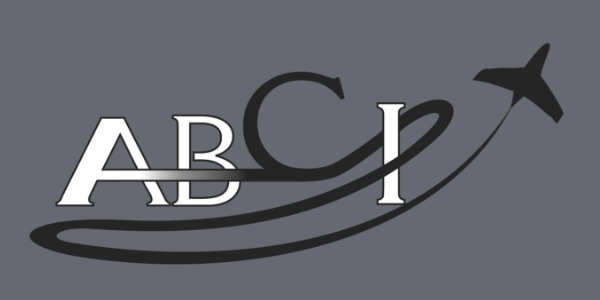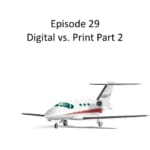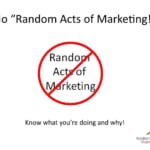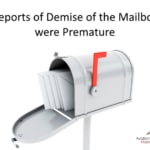After last week’s episode, we received lots of comments from people advocating . . . (drumroll, please) PRINT media for aviation advertising. We decided to dedicate an entire episode to encouraging the use of at least one print element in every marketing campaign. The trick is to use print in a way that makes the most of its advantages (credibility and convenience) while mitigating its limitations (untraceability and cost) by integrating print and digital elements in a powerful campaign.
![]()
![]()
![]()
Transcript – Print Vs. Digital, Round 2!
Paula Williams: Welcome to Aviation Hanger Flying, Episode number 29. Today we’re going to talk about Digital versus Print, Part 2. I’m Paula Williams.
John Williams: And I’m John Williams, together we are ABCI. And our mission is-
Paula Williams: To help aviation companies sell more of their products and services. So just recently we started using a hashtag for conversation about our podcasts or our webinars or anything else, for that matter.
We promise to reply to any hashtag that uses, or any Tweet or Facebook share, or anything else that uses this hashtag and we will reply to every Tweet. So that hashtag is #AvGeekMarketing. All right. So now our motto is “No random acts of marketing!” We want to know what you’re doing and why.
So after last week’s episode, when we talked about print versus digital and some of the pros and cons of each, some people, of course, everybody has an opinion, don’t they, John?
John Williams: Yes, they’re like other things. Everybody’s got at least one.
Paula Williams: All right, and some people have more than one.
John Williams: [LAUGH] Yeah.
Paula Williams: Which is fine, too, but a lot of people are very, very biased in favor of digital right now because it gives you the opportunity to see who’s clicking on your links. You can do some great analytics. You can account for your money a lot more effectively than you can in print.
Another thing that it allows you to do is spend less money and also you can work from anywhere. So if you don’t have a physical location, it’s kind of hard to do print unless you outsource that to a great print shop like we do, right?
John Williams: Exactly.
Paula Williams: Okay, but there’s a great quote from Mark Twain, that the rumors of my death have been greatly exaggerated.
And we found that the same is really true of print, reports of the demise of the mailbox were premature. There was probably an equal or greater number of emails and tweets and other things that we got indicating that they really like the aviation catalogs. They really like the printed publications.
They really like a lot of those things. And John, I think you fall into that camp, is that right?
John Williams: By and large, I like pieces of paper. I prefer books that are on paper in front of me that I can flip back and forth. Yeah, you can’t put a bookmark like you can on some of the readers, but that’s okay.
You also don’t get the opportunity, in my opinion, to flip back and forth and reread stuff just because you can recognize what page it came from.
Paula Williams: Exactly, and John really is, we like to say, our target demographic in the aviation industry. Gender, age, military experience, education, all of that stuff usually falls squarely within the category of this is the perfect person to market to.
So the things that John likes tend to be the kinds of things that work really with aviation customers, so we take that very seriously. One of the problems with the aviation industry is that, especially when you get really specific, a lot of our companies sell very specific products that are components or software or maintenance processes, services and things like that for a very specific group of people.
And it’s really hard to do testing for a very specific group of people. And it’s hard to have statistics on hand about what’s going to work for them and what’s not going to work for them, so we like to use statistics from some bigger companies. And one thing that we got in the mail from a friend of ours that’s in one of our Mastermind groups, and of course it came the week after we did our last podcast, was a really great article, Direct Mail Breaks Outdated Marketing Assumptions.
And this is by Sean Buck, who’s in one of our Mastermind groups. And we’ll tell you a little bit more about him in just a minute. But if you are familiar with Costco, and who’s not familiar with Costco, right?
John Williams: Exactly, they’re everywhere, they’re everywhere.
Paula Williams: They’re everywhere.
And they’re one of those companies that has the numbers that is able to do the kind of testing that we wish we were able to do,
Paula Williams: In the aviation industry, right? [LAUGH] Yeah, our studio’s got everything but an espresso maker.
John Williams: [LAUGH] You still can’t make up for the fact that sometimes you need a drink of something to get your throat clear.
Paula Williams: Exactly, so, Costco sends 8.6 million magazines and catalogs per month. They are the third largest monthly publication in the world. The average member who receives a Costco Connection has a household income of 156,000 which actually puts them in the affluent category. And 56% of their members who receive monthly magazine buy something based off of what they read in the magazine.
John Williams: That’s crazy.
Paula Williams: That’s crazy. Now it’s really hard to isolate, and especially with print, it’s very, very difficult to say, did they see it in the store first and then see it in the catalog, and then they mentioned the catalog when they called in to buy it.
We really don’t know, and that’s-
John Williams: Unless.
Paula Williams: Yeah?
John Williams: Unless there happens to be a, what do they call those little things, those QR codes?
Paula Williams: QR codes.
John Williams: Something you can zap with your smartphone and if you do it right, then when they zap that, you know where it came from.
Paula Williams: Right, but there is a limitation with that. It only shows the last action before they took that action. So you don’t know if they were in the store the week before, and came in and looked at the thing and sat on the patio furniture that they’re going to buy, and did all of the crazy things that they want to do during the research for this product before they actually made the purchase.
John Williams: Yeah, but does it matter?
Paula Williams: It does, it does matter. But the point being, we have to go with the numbers that we have. We have to go with the best information we can put together. So you could say that what if they didn’t do print, okay, so, they did a test.
And actually, during the Great Recession, which was 2008, 2009?
John Williams: Seven, I think, or-
Paula Williams: Yeah, somewhere-
John Williams: Between 2007 and 2009, somewhere in there.
Paula Williams: In that category, whenever they actually say that that started, they,
Paula Williams: Considered discontinuing the print version of their magazine. And they did a survey, and found that their affluent members, which is pretty much all Costco members, overwhelmingly prefer the print edition.
Ginnie Roeglin, the Senior VP of Costco’s e-commerce and publishing, says she expects the print edition to the magazine to continue to grow in circulation for many years to come. So when a company as big as Costco is making decisions like this, then companies as small as some of the ones that are in our membership, or our group of folks that do marketing for aviation products, really should sit up and take notice because they have numbers that we will never have.
And they can do testing that we can never do, and they can do research that just makes us drool. Okay, you might say, well, Costco is just odd, and maybe it is. These are people who buy cases and cases of toilet paper, right?
John Williams: And sell the same like that.
Paula Williams: Exactly. But Williams-Sonoma is actually the parent company to seven companies, including the Pottery Barn and West Elm. But 50% of their company’s marketing budget is spent on printed catalogs each year. And that’s for the seven brands including Williams-Sonoma, Pottery Barn and West Elm. So once again, we have an affluent clientele.
We have the opportunity to do digital. If you’ve ever been to Williams-Sonoma’s website, you know they’ve spent a lot of money on that thing. I mean it’s got some beautiful photography, it’s got recipes. You could spend days on there on their website. But they spend at least 50% of their budget on print.
Now if we could get away without doing print, we would. We would much prefer to be able to work from anywhere. We would much prefer not to have to turn our conference room into a mailing room every Friday to send out catalogs and other kinds of things. But we found that these things are just much more effective than we would like them to be for those of us who prefer print or for those of us who prefer digital because of the trackability of it.
All right, so you could say, and maybe you will, hey, Costco and Williams-Sonoma and those brands are older people. And you do have a point there, but here’s another brand, and this is Bonobos, which is actually kind of one of the younger, hipper men’s clothing brands, I would say.
And [COUGH] you would think that a younger hipper men’s clothing brand would concentrate most of their money and time and energy on the web, right?
John Williams: Yes.
Paula Williams: Well, 20% of Bonobos’ first time customers are placing orders because they received a printed catalog in the mail.
John Williams: Crazy.
Paula Williams: Yeah, so it is crazy, but the same catalog buyers are spending 1.5 times as much as first time buyers who did not receive a catalog and who were just buying online. So there is still a tradition in this country, and as far as I know, this is all US, if anybody’s got data from elsewhere, I’d love to see it.
But still, people are doing a lot more purchasing based on paper. And I’m not sure if that’s the credibility factor, if that’s the convenience factor of having something in your hands, what exactly is it that’s causing people to spend money when they have something on paper rather than online?
And I think if you had to boil it down it would probably come down to credibility, wouldn’t you think?
John Williams: I’m not sure because we at, what’s that magazine I can’t pronounce, Hanneker and-
Paula Williams: Hammacher Schlemmer, yeah.
John Williams: [LAUGH] And I like to look in it because you can look at pictures and it just seems more, maybe it is credibility, seems more real.
You see a picture, you see it described. And yeah, you can do all that on the web but somehow it’s different.
Paula Williams: Yeah, well on the web you can see the pictures move, they have videos and things.
John Williams: Yeah, I know, but with rare exceptions, you can bypass the video because you can let your brain work on that, right?
Paula Williams: Mm-hm.
John Williams: And you see, but you read all of the pertinent data and, I don’t know, it just seems, I can sit on a couch with a cup of coffee and peruse that. I don’t have to be at my desk. I don’t have to be worrying about what to do with the mouse and spilling coffee on the keyboard.
So, I don’t know, I’m not quite sure really, but to put too fine a point on it is I wouldn’t know what to say, but I like the magazine.
Paula Williams: Okay, and I would say that Americans for generations have been trained to look in catalogs, figure out what they want, whip out their credit card and make purchases ever since the old JCPenney catalogs.
John Williams: Which makes you wonder and gives you pause, If Amazon were to put a catalog out.
Paula Williams: How they would do, and that’s a good question. It’d be interesting to see. And what would they put in it? I mean, they’ve got such a huge inventory.
John Williams: Well, it’d be like the old Sears catalogs from way back when you went to a catalog store just to look at the catalog.
Because the catalog’s so huge, you can’t lift it. That’s right, talk about a four-inch thing with microthin paper
Paula Williams: Mm-hm, okay, so one more example. Neiman Marcus has found that they get $4 back in sales for every dollar that they spend on producing, printing, and mailing a catalog.
Now that is absolutely staggering. Now if you could make $4 back for every dollar that you spend on a particular kind of advertising, you’d just be shoveling every dollar you could get your hands on into that form of advertising.
John Williams: Absolutely.
Paula Williams: And you’d do that all day long.
John Williams: That’s crazy.
Paula Williams: It is, all right, so obviously, print still has a lot of validity and anybody who is thinking about completely eliminating print from their repertoire is out of their mind so-
John Williams: And should think again.
Paula Williams: And should think again. And you know this is interesting because with every client we have ever had, we always end up having to arm wrestle with them to get them to do anything with print, and it’s partly because of the expense.
And I understand that.
John Williams: True.
Paula Williams: And partly because of the inconvenience, because you end up getting some return address, or return bad addresses and other kinds of things.
John Williams: I think probably the negative isn’t the client. They’ve all put glossy ads in magazines, a one time shot for one month out of 12.
Or maybe even recurring and they got no way to track, and they don’t think it does any good.
Paula Williams: Because they did a random act of marketing.
John Williams: That’s right.
Paula Williams: It didn’t work. They think print is bad.
John Williams: Or maybe it did work and they don’t know how to prove it.
Paula Williams: Yeah, so it was not replicatable because it was not part of a system. So whatever you do, you need to make sure that it’s disciplined, and it’s measured, and it’s part of a marketing system. But, every marketing system should include some print. And I can’t think of any scenario in which there would be an exception to that.
But yeah, I told you about Sean Buck. He’s a great guy. He’s in a lot of our Mastermind groups. And he runs a company called The Newsletter Pro. And what they do is they put together newsletters for different companies. And he specializes, I think, in dentists and a lot of other professions, service professions, things like that.
And we may end up doing some business with him in the future for our clients, so stay tuned. We’ll keep you informed as we like to leverage smart people’s brains in different specialties that are outside of aviation course. So, and you could make the argument, what does all this have to do with aviation?
Okay, all the examples that we gave you were affluent customers, right?
John Williams: Yes.
Paula Williams: Mm-hm, some of them have older customers and most of our aviation clients also have people who are in their 40s, 50s and above, things like that as their target customer. Some of our folks, like the software folks and the training companies, are targeting younger male customers.
So that would be similar to Bonobos and their target market.
John Williams: And some of the young folks, they call them nouveau rich? [LAUGH]
Paula Williams: Yeah, exactly, the software kids, the Silicon Valley folks.
John Williams: Well, whatever, I mean they’re 30, give or take, and have money to spend.
Paula Williams: Absolutely.
But in all of these examples, their numbers are larger than ours. There is no way that we would be able to test an 8.6 million piece mailing. Costco can do that. Nobody that we know could.
John Williams: Even our marketing group, when they do split testing, they do it on several hundred thousand, rather than millions.
Paula Williams: Exactly, so when somebody has a really big set of data that, and John, you can talk more about how much more reliable statistics are when you have a larger sample set, right?
John Williams: Of course, the larger the universe, the more you can test, the more the numbers mean something.
Paula Williams: Exactly so that’s a problem we’re constantly running into in aviation is the small test size can be thrown off by one or two outliers that really mess up our numbers, right?
John Williams: Yeah, and if you threw out the outliers, what you have left is not much because of the size of the universe.
Paula Williams: Exactly, right, okay, so what does this boil down to? What does this mean to you? We think that you should include at least one print component in every campaign and we do this all the time. We try to include at least one print component, and here’s some examples on how you can do that.
You can have a postcard that leads to a call to action on the web. For example, go to this web page and order a free book about this topic. Or you could send a printed catalog that goes to online demos and videos of each of your products. That’s one way to combine print and online.
Another way you can combine print and online is you use online leads. You use online lead capture like some of the very highly targeted, re-targeting or Facebook ads and other kinds of things to get people to your website to request a printed information package. In all of those examples, you’re using online to save money and to track your numbers and to do all of the wonderful things that print does for you while you are also including one print element that gives you that credibility and that advantage that print does, right?
John Williams: Yep, and you should listen to your customer. If they say they want more printed matter, then consider that.
Paula Williams: Exactly, so a lot of folks that have a newsletter or whatever, you could always ask your customers if they want the printed version, the online version or both.
Because if they want both, it doesn’t cost you any more to also send them the online version. And you really, really, really do need to have a printed newsletter, I think, that you send out at least probably quarterly, depending on your customers, and depending on what you’re doing, so.
All right so, the freebie this week is still our Aviation Brand Design Brief Template.
Paula Williams: The template is actually a really good way to show some consistency so that people can see when they get one of your printed materials and then they go online having those design elements, your logo, your colors, your fonts.
All of those design elements will really help you maintain a consistent appearance, whether you’re using print or whether you’re using digital. And that’s something that we’ve seen a lot of errors and a lot of problems with in aviation is where they have one department doing their print, or they outsource their print maybe to a print shop or a graphic designer that specializes in print.
And then they have their webmaster do all of their online graphics, and then they end up looking like two completely different companies. So you don’t really know for sure. At least there is a moment of uncertainty when you take that printed catalog and then you go to buy something online and it looks like a completely different company.
John Williams: Consistency is key here.
Paula Williams: Mm-hm.
John Williams: And you may not have to go as completely nutso on consistency as some of the big names like IBM and Wells do, but the more consistent the better.
Paula Williams: Exactly, and using that brand template will help you do that across the board regardless of whether you’re using subcontractors or printers or other folks to do some of that work for you.
All right, so go sell more stuff. America needs the business.
John Williams: Zig Ziglar.
Paula Williams: Yep, absolutely, subscribe to our podcast, aviation marketing Hangar Flying. It is on iTunes, Stitcher, and Google Play. And please do leave us a review. See you next week.
John Williams: Ciao.
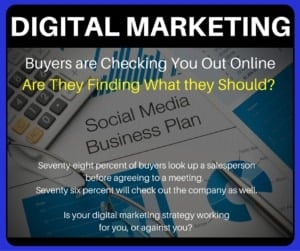 Did you know . . .ABCI offers Digital Marketing for Aviation companies?
Did you know . . .ABCI offers Digital Marketing for Aviation companies?
Other Digital Marketing Topics
Aviation Digital Marketing Glossary
Aviation Digital Marketing – Please Enjoy Responsibly!
6 Prospecting Methods Using Aviation Digital Marketing
The Digital Citizen – Why You Should Hire One (Or Be One!)
A Quick Tip for Getting More Online Reviews!
#FollowFriday – Aviation Inbound Marketing & Sketchy Prospects
[/fusion_builder_column][/fusion_builder_row][/fusion_builder_container]